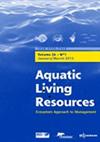Gravel washing as a lacustrine spawning habitat restoration method for smallmouth bass
IF 1.9
4区 农林科学
Q3 FISHERIES
引用次数: 0
Abstract
Smallmouth bass (Micropterus dolomieu) spawn on gravel and cobble in the littoral zone of lakes that may become degraded by the presence of fine sediments and decomposing organic matter. Substrate size and composition have been identified as important variables for nest site selection by male smallmouth bass. We tested whether ‘cleaning’ substrate by removing sediment with a pressure washer would increase the number of bass nests or the average total length (mm) of nesting smallmouth bass in selected areas of Big Rideau Lake, Ontario, Canada the following year using a before-after control-impact design. Treatment was not a significant predictor of nest abundance or average male length. Considering the strength of the experimental design it is reasonable to conclude that this intervention failed to enhance spawning substrate for smallmouth bass. Understanding the factors that maintain productive spawning sites for smallmouth bass is important to restoration effectiveness and determining where habitat enhancement will provide the greatest benefits.
小口黑鲈湖泊产卵栖息地的洗砾恢复方法
小嘴鲈鱼(Micropterus dolomieu)在湖泊沿岸的砾石和鹅卵石上产卵,这些砾石和鹅卵石可能因细小沉积物和分解的有机物的存在而退化。基质的大小和组成是影响雄性小嘴黑鲈择地的重要因素。第二年,在加拿大安大略省大里多湖(Big Rideau Lake)的选定区域,我们使用前后控制影响设计测试了用压力清洗机清除沉积物“清洁”基质是否会增加鲈鱼巢穴的数量或筑巢小嘴鲈鱼的平均总长度(毫米)。处理并不是巢丰度或平均雄鸟长度的显著预测因子。考虑到实验设计的强度,可以合理地得出结论,该干预措施未能改善小口鲈鱼的产卵基质。了解维持小口黑鲈产卵地点的因素对恢复效果和确定栖息地改善将提供最大利益非常重要。
本文章由计算机程序翻译,如有差异,请以英文原文为准。
求助全文
约1分钟内获得全文
求助全文
来源期刊

Aquatic Living Resources
农林科学-海洋与淡水生物学
CiteScore
2.30
自引率
0.00%
发文量
10
审稿时长
>24 weeks
期刊介绍:
Aquatic Living Resources publishes original research papers, review articles and propective notes dealing with all exploited (i.e. fished or farmed) living resources in marine, brackish and freshwater environments.
Priority is given to ecosystem-based approaches to the study of fishery and aquaculture social-ecological systems, including biological, ecological, economic and social dimensions.
Research on the development of interdisciplinary methods and tools which can usefully support the design, implementation and evaluation of alternative management strategies for fisheries and/or aquaculture systems at different scales is particularly welcome by the journal. This includes the exploration of scenarios and strategies for the conservation of aquatic biodiversity and research relating to the development of integrated assessment approaches aimed at ensuring sustainable and high quality uses of aquatic living resources.
 求助内容:
求助内容: 应助结果提醒方式:
应助结果提醒方式:


